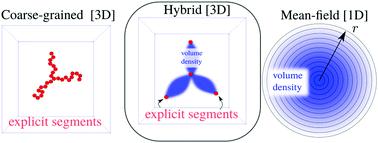当前位置:
X-MOL 学术
›
Soft Matter
›
论文详情
Our official English website, www.x-mol.net, welcomes your feedback! (Note: you will need to create a separate account there.)
Computer modeling of polymer stars in variable solvent conditions: a comparison of MD simulations, self-consistent field (SCF) modeling and novel hybrid Monte Carlo SCF approach
Soft Matter ( IF 3.4 ) Pub Date : 2020-10-29 , DOI: 10.1039/d0sm01080d Alexander D. Kazakov 1, 2, 3, 4, 5 , Varvara M. Prokacheva 1, 2, 3, 4, 5 , Filip Uhlík 1, 2, 3, 4, 5 , Peter Košovan 1, 2, 3, 4, 5 , Frans A. M. Leermakers 6, 7, 8, 9
Soft Matter ( IF 3.4 ) Pub Date : 2020-10-29 , DOI: 10.1039/d0sm01080d Alexander D. Kazakov 1, 2, 3, 4, 5 , Varvara M. Prokacheva 1, 2, 3, 4, 5 , Filip Uhlík 1, 2, 3, 4, 5 , Peter Košovan 1, 2, 3, 4, 5 , Frans A. M. Leermakers 6, 7, 8, 9
Affiliation

|
Computer-aided modeling is a systematic approach to grasp the physics of macromolecules, but it remains essential to know when to trust the results and when not. For a polymer star, we consider three approaches: (i) Molecular Dynamics (MD) simulations and implementing a coarse-grained model, (ii) the self-consistent field approach based on a mean-field approximation and implementing the lattice model due to Scheutjens and Fleer (SF-SCF) and (iii) novel hybrid Monte Carlo self-consistent field (MC-SCF) method, which combines a coarse-grained model driven by a Monte Carlo method and a mean-field representation driven by SF-SCF. We compare the performance of these approaches under a wide range of solvent qualities. The MD approach is formally the most exact but suffers from reasonable convergence. The mean-field approach works similarly in all solvent qualities but is quantitatively least accurate. The MC-SCF hybrid allows us to combine the benefits of the simulation route and the effective performance of SCF. We consider the center-to-end distance Rce, the radius of gyration Rg2 of the star and the polymer density profiles φ(r) of polymer-segments in it. All three methods show a good qualitative agreement one to another. The MC-SCF method is in good agreement with the scaling predictions in the whole range of solvent quality values showing that it grasps the essential physics while remaining computationally in bounds.
中文翻译:

可变溶剂条件下聚合物星的计算机建模:MD模拟,自洽场(SCF)建模和新型混合蒙特卡洛SCF方法的比较
计算机辅助建模是掌握大分子物理学的一种系统方法,但是知道何时信任结果以及何时不信任结果仍然至关重要。对于聚合物恒星,我们考虑三种方法:(i)分子动力学(MD)模拟和实现粗粒度模型;(ii)基于均值场近似的自洽场方法并由于以下原因实现晶格模型: Scheutjens和Fleer(SF-SCF)以及(iii)新型的混合蒙特卡洛自洽场(MC-SCF)方法,该方法结合了由蒙特卡洛方法驱动的粗粒度模型和由SF-S驱动的均值表示SCF。我们在多种溶剂质量下比较了这些方法的性能。MD方法在形式上是最精确的,但存在合理的收敛性。平均场方法在所有溶剂质量上的工作方式相似,但在定量上最不准确。MC-SCF混合动力使我们能够将模拟路线的优势和SCF的有效性能相结合。我们考虑中心到末端的距离R ce,恒星的回转半径R g 2和其中的聚合物段的聚合物密度分布φ(r)。所有这三种方法都显示出良好的定性一致性。MC-SCF方法与整个溶剂质量值范围内的比例缩放预测非常吻合,表明它在掌握计算范围的同时掌握了基本物理原理。
更新日期:2020-11-17
中文翻译:

可变溶剂条件下聚合物星的计算机建模:MD模拟,自洽场(SCF)建模和新型混合蒙特卡洛SCF方法的比较
计算机辅助建模是掌握大分子物理学的一种系统方法,但是知道何时信任结果以及何时不信任结果仍然至关重要。对于聚合物恒星,我们考虑三种方法:(i)分子动力学(MD)模拟和实现粗粒度模型;(ii)基于均值场近似的自洽场方法并由于以下原因实现晶格模型: Scheutjens和Fleer(SF-SCF)以及(iii)新型的混合蒙特卡洛自洽场(MC-SCF)方法,该方法结合了由蒙特卡洛方法驱动的粗粒度模型和由SF-S驱动的均值表示SCF。我们在多种溶剂质量下比较了这些方法的性能。MD方法在形式上是最精确的,但存在合理的收敛性。平均场方法在所有溶剂质量上的工作方式相似,但在定量上最不准确。MC-SCF混合动力使我们能够将模拟路线的优势和SCF的有效性能相结合。我们考虑中心到末端的距离R ce,恒星的回转半径R g 2和其中的聚合物段的聚合物密度分布φ(r)。所有这三种方法都显示出良好的定性一致性。MC-SCF方法与整个溶剂质量值范围内的比例缩放预测非常吻合,表明它在掌握计算范围的同时掌握了基本物理原理。



























 京公网安备 11010802027423号
京公网安备 11010802027423号